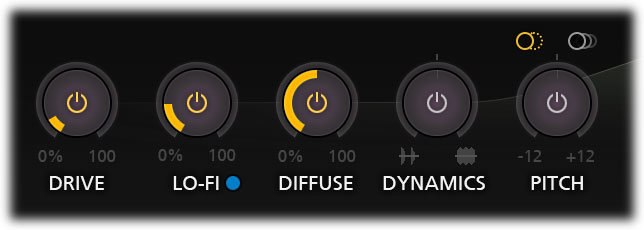FabFilter Timeless 3 online help
Table of contents
Go to sectionFabFilter Timeless 3 Help
Introduction
Using FabFilter Timeless 3
Drag-and-drop modulation slots
Full Screen mode, resizing and scaling
Presets
Purchasing FabFilter Timeless 3
Purchasing FabFilter Timeless 3
Support
Effects
To the left of the main delay controls, you will five different effects that can be used to color the signal in pleasant ways. All the effect amounts can be modulated.
Clicking once at the center of an effect knob will enable or disable the effect. Clicking and dragging on the knob will change the amount. Double-clicking anywhere in the knob will enable text entry for the effect amount value.

- The Drive knob sets the level at which the main input of the delay is driven. Higher amounts will make the internal saturation more and more apparent.
- The Lo-Fi effect is a well-tuned combination of sample rate- and bit depth reduction. It can be used to pleasantly degrade the signal, from a subtle, vintage edge all the way to total destruction. At low amounts, this gives a nice character and vintage progression to the feedbacked delays.
- The Diffuse knob sets the diffusion of the internal delay buffer, beautifully blurring the delayed and feedbacked audio. At low amounts, this affects transients mainly, but using large amount results in lush, reverb-like effects. Try modulating this with an EG or EF!
- The Dynamics knob can be used to either gate or compress the incoming audio. Turning the knob to the right will add heavily pumping compression, while turning the knob to the left will introduce great all-purpose gating/expansion.
-
The Pitch knob enables pitch shifting, ranging from an octave down to an octave up. Note: when enabled, the minimum possible delay time is raised to 45 ms (instead of the normal 5 ms minimum).
Enable the Pitch Shift Mirroring button at the left top of the knob to invert the pitch shift amount in the right channel. In combination with a small shift, this can be used to create chorus-like effects.
With the Pitch Shift Routing button you can set whether pitch shifting is applied before the sound is fed back to the input, or afterwards. When routed within the feedback path, the pitch will change more and more for every repetition of the sound. When placed outside the feedback path, the pitch change will be applied just once, to the final wet signal.
Tips
- Modulation is a great way to get more out of these effects. You can achieve very cool results, for example by modulating the Duffuse knob with an EG or EF, or modulating Drive with an EF in Transient mode.
Next: Delay display
See Also
Overview
